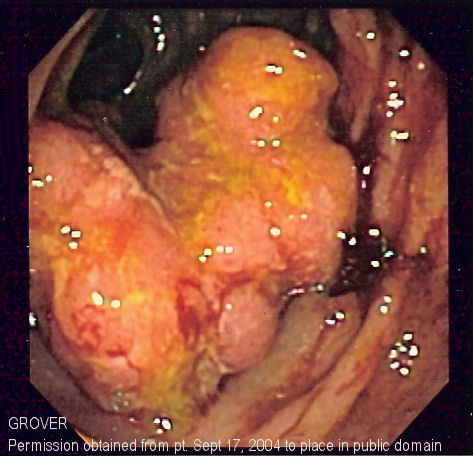Crohn's disease natural history, complications and prognosis
|
Crohn's disease |
|
Diagnosis |
|---|
|
Treatment |
|
Case Studies |
|
Crohn's disease natural history, complications and prognosis On the Web |
|
American Roentgen Ray Society Images of Crohn's disease natural history, complications and prognosis |
|
FDA on Crohn's disease natural history, complications and prognosis |
|
CDC on Crohn's disease natural history, complications and prognosis |
|
Crohn's disease natural history, complications and prognosis in the news |
|
Blogs on Crohn's disease natural history, complications and prognosis |
|
Risk calculators and risk factors for Crohn's disease natural history, complications and prognosis |
Editor-In-Chief: C. Michael Gibson, M.S., M.D. [1]
Overview
Natural History , Complications and Prognosis
- Complications

Crohn's disease can lead to several mechanical complications within the intestines, including obstruction, fistulae, and abscesses. Obstruction typically occurs from strictures or adhesions which narrow the lumen, blocking the passage of the intestinal contents. Fistulae can develop between two loops of bowel, between the bowel and bladder, between the bowel and vagina, and between the bowel and skin. Abscesses are walled off collections of infection, which can occur in the abdomen or in the perianal area in Crohn's disease sufferers.
Crohn's disease also increases the risk of cancer in the area of inflammation. For example, individuals with Crohn's disease involving the small bowel are at higher risk for small intestinal cancer. Similarly, people with Crohn's colitis have a relative risk of 5.6 for developing colon cancer.[1] Screening for colon cancer with colonoscopy is recommended for anyone who has had Crohn's colitis for eight years, or more.[2]
Individuals with Crohn's disease are at risk of malnutrition for many reasons, including decreased food intake and malabsorption. The risk increases following resection of the small bowel. Such individuals may require oral supplements to increase their caloric intake, or in severe cases, total parenteral nutrition (TPN). Most people with moderate or severe Crohn's disease are referred to a dietitian for assistance in nutrition.[3]
There are many complications that can come with Crohn's disease like: obstructions, abscesses, free perforation, and hemorrhage.[4]
Women with Inflammatory bowel disease shows that they "face a higher risk of adverse outcomes related to pregnancy, according to a report in the October issue of Gastroenterology" [2].
Prognosis
Crohn's disease is a chronic condition for which there is currently no cure. It is characterized by periods of improvement followed by episodes when symptoms flare up. With treatment, most people achieve a healthy height and weight, and the mortality rate for the disease is low. Crohn's disease is associated with an increased risk of small bowel and colorectal carcinoma.[5]
Crohn's cannot be cured by surgery, though surgery does happen with blockages, whether partial or a full blockage occurs. After the first surgery, the Crohn's usually shows up at the site of the resection though it can appear in other locations. After a resection, scar tissue builds up which causes strictures. A stricture is when the intestines becomes too small to allow excrement to pass through easily which can lead to a blockage. After the first resection, another resection may be necessary within five years of the first surgery. [3]
Many patients will have temporary stoma formations together with possible associated complications. [4]
=References
- ↑ Ekbom A, Helmick C, Zack M, Adami H (1990). "Increased risk of large-bowel cancer in Crohn's disease with colonic involvement". Lancet. 336 (8711): 357–9. PMID 1975343.
- ↑ Collins P, Mpofu C, Watson A, Rhodes J. "Strategies for detecting colon cancer and/or dysplasia in patients with inflammatory bowel disease". Cochrane Database Syst Rev: CD000279. PMID 16625534.
- ↑ Evans J, Steinhart A, Cohen Z, McLeod R (2003). "Home total parenteral nutrition: an alternative to early surgery for complicated inflammatory bowel disease". J Gastrointest Surg. 7 (4): 562–6. PMID 12763417.
- ↑ "Complications of Crohn's Disease". Retrieved 2008-01-16.